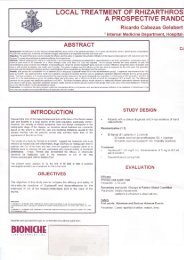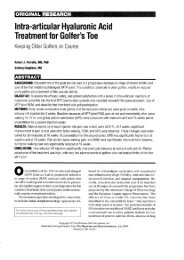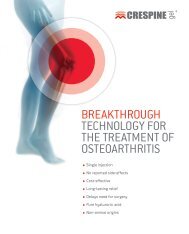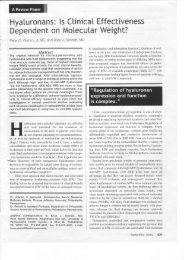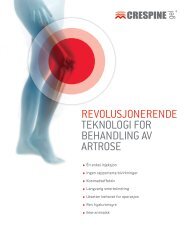OSTEOARTHRITIS CARTILAGE - Crespine Gel
OSTEOARTHRITIS CARTILAGE - Crespine Gel
OSTEOARTHRITIS CARTILAGE - Crespine Gel
- No tags were found...
You also want an ePaper? Increase the reach of your titles
YUMPU automatically turns print PDFs into web optimized ePapers that Google loves.
Osteoarthritis and Cartilage (1997) 5' 153-i60O 1997 Osteoarthritis Research Society<strong>OSTEOARTHRITIS</strong>and<strong>CARTILAGE</strong>106+-4584/97i030r53 + 08 $12,00i0Arthroscopic evaluation of potential structure modifying activityof hyaluronan (Hyalgan@) in osteoarthritis of the kneeBv VÉnoNrqus Lrsrnar, Xevrrn Avn^a,r,, FnaNcnsca PerenNcr-r-o*, JraN-Paul Boxvanr,sr,JnsN SrvroxNnr. BpnNann Auon eNo Maxrue DoucanosClinique de Rhumatologie Hôpital Cochin, 27 rue du Fg Saint-Jacques 75014 Paris, France; and*DepartmentMedical, Fidia S.p-A. Abano Terme, ItalySummaryObjective: Several reported studies suggest that repeated intra-articular injections of hyaluronan result in sustainedrelief from pain and functional disability in patients with knee osteoarthritis- Several in uiuo data suggest thathyaluronan might have a beneficial structural effect in osteoarlhritis. The objective of the study was to evaluate thepotential structure-modifying effects ofHyalgan (500-730 kDa molecular weight), a highly-purified sodium hyaluronate.Design: Patients with painful khee osteoarthritis (ACR criteria) were enrolled in a prospective, controlled study ofl-year duration. After randomization, either conventional therapy or three cycles (every 3 months) of threeintra-articular injections of Hyalgan (once a week during 2 weeks) were given. Clinical outcome was added using painvisual analog score (VAS), functional impairment: Lequesne's index, quality of life: arthritis impact measutement scale(AIMS2) and structural outcome using X-rays: joint space narrowing and arthroscopy: global assessment using VAS,SFA scoring and grading systems.Results: Of the 39 recruited patients, 36 completed the l-year trial (19 in the Hyalgan group and 17 in the controlgroup). There was no difference between groups at entry. Between-group comparison for changes in clinical parametersreached statistical significance for the quality of life index (AIMST: -0.4 + 0.7 vs +0.2 + 0.9 in the Hyalgan and controlgroups respectively, P < 0.05). Deterioration in the structural parameters was less in the Hyalgan group, with astatistically significant difference for two of the three evaluated parâmeterc (overall assessment of chondropathy:+5.I + 12.7 vs 16.7 + 18.3. P=0.016; SFA scoring system: +3.7 + 7.3 vs +9.0 + 11.5, P=0.05) in the Hyalgan and controlgroups, respectively.Conclusions: This study supports existing data concerning the favorabie symptomatic effect of intra-articularinjections of Hyaigan in osteoarthritis of the knee and suggests that repeated intra-articular injections of Hyalganmight delay the structurai progression of the disease. Other studies are required to confirm these results and todetermine the long-term monitoring of osteoarthritic patients using such local therapy.Key words: Knee osteoarthritis, Arthroscopy, Hyaluronan.IntroductionDnucs considered to be active in the treatment ofosteoarthritis may be classified as symptomaticand/or structure-modifying agents [1, 2]. Monitoringthe effects of symptomati.c agents in patientssuffering from osteoarthritis ofthe knee is usuallybased on clinical measurements of changes in painand/or function [3, aJ. Such outcome measures maybe inffuenced by effective symptomatic agentswhatever their mechanism of action f5.6l but doReceived 11 July 1996; accepted 1 November 1996.Address correspondence to: Maxime Dougados, Clinique deRhumatoiogie, Hôpital Cochin, 27 rue du Fg Saint-Jacques,75014 Paris, France.This study was supported by a grant from Fidia, S.p.A. Italy andin part by a grant from the Société Française de Rhumatologie.not permit the evaluation of the potential of thesedrugs to act directly on the cartilage. TheInternational League of Association for Rheumatologyhas defined chondroprotective agents asagents capable of preventing, delaying, or evenreversing cartilage lesions due to osteoarthritis inhumans. However, the outcome measures forcartilage lesions are not clearly established.Radiographic assessment of affected knees hasbeen reported as an objective standard forlong-term evaluation of knee osteoarthritis [7,8]but is still tainted by false-positive and falsenegativefindings [9J.It was reported in a previous study [10] that(1) arthroscopic evaluation of articular cartilageof the knee was not simple, but was feasible andwell-tolerated as an outpatient procedure under| É?
154 Listrat et al.: Hyaluronân in osteoarthritis of the kneeIocal anesthesia with a small arthroscope; (2) thequantification of chondropathic severity wasfeasible using either the physician's overallassessment with a 100 mm visual analog scale(VAS) or the scoring systems proposed by theFrench Society of Arthroscopy which are compositeindices taking into account the three maincharacteristics of chondropathy, i.e., localization,depth and size [11.12]. Previous studies haveshown that this method fulfills some of the guidelinesproposed for outcome measures: validity,reproducibility and clinical relevance [10-12].Hyaluronan (hyaluronic acid) forms the centralaxis of the various proteoglycan aggregatesnecessary for the functional integrity of cartilageand other extracellular matrices [13]. Hyaluronicacid is responsible for the unique viscoelasticproperties of the synovial fluid [1a-16] and isthought to play an important role in biologicalactivities as diverse as cell proliferation andactivation 117-201.'Its clinical use was suggestedby the finding thàt hyaluronic acid was reducedin concentration and in chain length in thesynovial fluids of arthritic patients [14]. The'viscosupplementation'termhas been used todescribe the effects of high-molecular-weighthyaluronan [21]. However, this concept is basedonly on the mechanical properties of the moleculewhile there is a considerable body of evidencethat the therapeutic efficacy of hyaluronan isdue to a combination of both physicochemicaland pharmacological properties [22].Several studies with various preparations ofhyaluronan of different molecular weights havebeen conducted [23-25 and reviewed in 26], andthere has been a broad consensus in the studiespublished that this treatment is well-tolerated andresults in sustained relief of pain and functionaldisability of patients suffering from knee osteoarthritis.This clinical improvement is usuallyobserved after three to five injections performed atl-week intervals. Moreover, a carry-over effect forat ieast 3 months after discontinuation has beensuggested.Animal model studies suggest that hyaluronanaffects the progression of chondral lesions [27,28].To our knowledge, no data have been published inthe literature suggesting that intra-articularinjections of hyaluronic acid might interfere withthe natural course ofthe cartilage lesions observedin knee osteoarthritis in humans. Therefore, itseemed interesting to conduct the following pilotstudy in order to evaiuate, by arthroscopy, theeffects of repeated intra-articular injections ofhyaluronan.Patients and MethodsPATIENTSPatients suffering from knee osteoarthritisfulfilling the American College of Rheumatologycriteria [29] were enrolled in the study. Otherinclusion criteria were the following:(1) primary osteoarthritis as defined by theAmerican College of Rheumatology [29];(2) clinical involvement of the medial compartment(pain localized at the medial part of theknee);(3) active disease (pain and disability) justifyinglocal therapy (lavage) at entry (based on theopinion of the investigator);(4) absence of contraindication of arthroscopy(anti-coagulant therapy, cutaneous lesion of theknee, allergy to lidocaine);(5) absence of advanced disease defined by aradiological grade fV according to the classificationproposed by Kellgren and Lawrence [30];(6) presence of chondropathy of the medialcompartment at arthroscopy defined by thepresence of chondropathy at least grade IIaccording to the classification proposed by Beguinand Locker [31] and observed on at least 10% oftheevaluated surface.Patients were not included in the study if (1) anyintra-articular surgery was performed during thepast 5 years (including any arthroscopic procedure).(2) Any intra-articular treatment wasprescribed i.e., lavage, intra-articular injection ofcort costeroids during the past 3 months. Anyconcurrent symptomatic treatment, i.e., analgesics,nonsteroidal anti-inflammatory drugs(NSAIDs), physiotherapy had to be stable for atIeast 1 month before the studv.STUDY MEDICATIONHyalgan@, supplied by Fidia S.p.A., is aconcentrated (20 mg12 ml) solution of 500-230 kDamolecular weight, highly-purified sodiumhyaluronate extracted from rooster combs.STUDY DESIGNThe study was a single-center, prospective,randomized, controlled study of l-year durationapproved by the ethics committee of CochinHospital, Paris. All patients underwent kneearthroscopy during which lavage (2 I saline.serum)was performed. After the arthroscopy procédure,and after written informed consent was obtained,the patients entered one of the two study groups :
Osteoarthritis and Cartilage Vol. 5 No. 3 155according to a randomization scheme. The controlgroup did not receive any intra-articular injectionof hyaluronan during the 1 year of the study. Thetreated group received three intra-articular injectionsof Hyalgan once a week during 2 weeks (threeinjections) every 3 months, for a total of nineinjections. The first injection was performed 1month after arthroscopy and the last 3 monthsbefore the final visit. Before each injection, anysynovial fluid was aspirated.Moreover, joint space width was evaluated by theinterbone distance between the media] femoralcondyle and the tibial plateau at the narrowestpoint in millimeters [8]. The paired radiographs ofeach patient at entry and after 1 year wereanalyzed by a single investigator (V.L.) using ablind procedure in which the investigator wasunaware ofpatient identity and the chronology ofthe radiographs.DATA COLLECTIONClinical characteristicsDemographic data and parameters of osteoarthritiswere recorded at entry for each patient, andincluded age, sex, body mass index, date of onsetof osteoarthritis, and number of joints affected byosteoarthritis. Moreover, clinical, radiological andarthroscopical variables were collected at entryand after 1 year.Ciinical activity of osteoarthritis was assessedusing the following variables: (1) global pain inthe previous 48 h evaluated on a 100 mm lengthVAS and (2) functional disability, evaluated via (a)Lequesne's functional index [32], which consists of10 questions regarding the presence of pain ordisability, and (b) the French version ofthe revisedarthritis impact measurement scale (AIMS, t331.These clinical parameters were collected by aphysician who was aware of the patient group. i.e.,using a non-blinded procedure. Moreover duringthe study, any requirement for concomitanttherapy, e.g., analgesics, NSAID was recorded. Theamount of this rescue treatment was calculatedusing the following methods: (1) an equivalentNSAiD score, previously reported [34], in order tocaiculate a mean, daily NSAID score. For example,a patient taking 100 mg indomethacin daily has ascore of 10, which is the same score if he/she takes150 mg diclofenac or 20 mg piroxicam, (2) anequivalent analgesic score defined by the numberofpills taken daily by the patient considering thatone pill of paracetamol is equivalent to one pill ofdextropropoxyphene.Radiolo gical uariab lesRadiological evaluation consisted of anteroposteriorweight-bearing knee X-rays. The structuralseverity of osteoarthritis waS.determined byevaluating the joint space narrowing according toa seven-grade scale. previously reported [35].ArthroscopyArthroscopy of the knee was performed underlocal anesthesia, without tourniquet hemostasis,with a 2.7 mm Storz arthroscope (Storz, Paris,France) having a 30" fore oblique lens, using theinferolateral approach. Each arthroscopy wasrecorded on a t inch U-MATIC video-cassette(Sony, Paris, France). All the videotapes wereanalyzed by a single investigator (X.A.) using ablinded procedure in which the investigator wasunaware of patient identity and chronology.Three scoring methods were used: the overallassessment of the investigator, the revised SFAscoring and the SFA grading systems [10-12]. Theoverall assessment of chondropathy was evaluatedusing a VAS 100 mm in length, in which 0indicates the absence of chondropathy and 100 themost severe chonclropathy. In the second andthird methods, i.e., the SFA systems for scoringand grading chondropathy [11, 12], the first step isrecording, on an articular diagram of the knee,the observed chondropathies with their mainbaseline parameters: (1) localization: medial femurand medial tibia, lateral femur and lateral tibia,patella and trochlea; (2) grade based on theclassification of chondropathy proposed by Beguinand Locker [31] in which grade 0 indicatesnormal cartilage, grade I swelling and/or softening,grade II superficial fibrillation, grade III deepfibrillation, and grade IV exposure ofsubchondralbone; and (3) size from 0-1000Â of the involvedarticular surface. Size of iesions is estimated bythe investigator as a percentage of the wholearticular surface and is reported on a special form[10-12].The revised SFA scoring is a continuousvariable, between 0 and 100, obtained as follows[10]: Revised SFA scoring=surface (%) of grade Ilesions x 0.14 * surface (%) of grade II lesions x0.34 + surface (%) of grade III lesions x 0.65 +surface (%) of grade IV lesionsx1.00.The SFA grading is an ordinal variableincluding four grades for the medial compartment1121.
156 Listrat et al.: Hyaluronan in osteoarthritis of the kneeTable IBaseline characteristics of the 39 patients suffering from knee osteoarthritis enrolledin the studyCharacteristicsDemographic dataAge (years) (mean, s.o.)Sex (F/M)Body mass index (kg/m'z) (mean, s.o.)OA characteristicsDisease duration (years)(man, s.o., range)Synovial fluid effusion (yes/no)Number of joints effected by OA(mean, s.n., range)Concomitant NSAiD therapyduring the previous 6 months(number of patients)*Statisticalsignifi cance determined by thefor the quantitative variables and by thevariables. NS = not significant.Treatment groupHyaluronanN= 2060+711/927.5 + 3.84(0-26)rol202.6 + 7-7(1-6)11ControlN= 19 P-value*64+8r5l426.6 + 3.6(0-15)10/192.6 + t.2(1-5)1lNSNSNSNSNSNSNSnonparametric Mann-Whitney U testChi-square test for the qualitativeStatistical analysisStatistical analyses were performed to compareby treatment group the baseline characteristics ofpatients and the changes which occurred in theclinical, radiologicai and arthroscopical variablesduring the study. For the continuous efficacyparameters, the anaiysis of covariance (ANCOVA)using the conesponding baseline (week 0) assessmentas the covariate was performed. Categoricalvariables were analyzed by chi-square test. Allstatistical tests for the efficacy variables wereperformed two-sided with a level of significancea = 0.05.Arthroscopic parameters have been chosen asthe a priori primary efficacy variables. However, atthe time the protocoi was designed, no particularscale had been chosen. In this manuscript, wereport the statistical analyses concerning the threearthroscopic parameters, i.e., the overall assessmentof chondropathy using a 100 mm length VAS,the SFA scoring system, the SFA grading system.Some additional analyses were performed on theeffect of concomitant therapy. NSAID treatmentcould potentially interact with progression of thestructural disease [35] and NSAID intake mightdepend on the efficacy of the study treatment (i.e.,the higher the treatment effect, the lower theexpected NSAID intake). Due to the lack ofindependence between the effect of the trearmenrand the need for concomitant treatments, onlyexploratory analyses were carried out. The aims ofthese analyses were to study the main effect ofNSAID intake on outcome and the effect of theinteraction between this variable and trcatment onoutcome.Table IISymptomatic seuerity of knee osteoarthritis by treatment groups in the 36 patients who completed. the I year stud.yEntry visit Final visit Difference from baselineClinical variablesPain(VAS, mm)Functional impairementLequesneLs indexQuality of lifeAIMS,(roral of t2 irems)*ANCOVAanalysis.HyaluronanN= 1949.2 + 20.18.9 + 4-12.6 + 1.3ControlN= 17HyaluronanN= 1952.1 + 16.8 32.4 + 25.59.4 + 3.5 7.2 + 4.8ControlN=77HyaluronanN= 19ControlN= 17 P-va]ue*46.8 + 27.7 -16.8 + 23.9 -5.2 + 36.6 0.13*8.1 + 4.1 -1.7 + 2.g -1.4 + 5.9 0.66*2.2 + 0.7 2.2 + r.3 2.4 + 7.1 -0.42 + 0.67 +0.18+ 0.88 0.047*
.4,.'., :.'Osteoarthritis and Cartilage Vol. 5 No. 3t57Èl*ôn (oôt OJ drôc{ co ooïlû)O O CJO# co u:c\ dj-ig.jÊdoq.ôcq +t +l +lË"1ts- tqc)ad#:ilÈ-#cD ô.i o?!o Êtrq.-.1 È +t +l +lo)!i n\d rôcôo) IIti.o)->>ËËlËËlÈilks3la!-r.- Èl dé= I9lo s sl-o s ÈldsàlF àSIëglkàSË|ts^€ËË gË '.8c> cD ôt c\r F- cô +lqdO(Or$ôr(oÈ+l+.jôiôl (J rô tso:ô!æÊc\ c\+t +ldd(0$qqq(.oæc\Ê+t +lqogÈ- O).+ ôlcq\cloôlÊ cô ôt${lôlrôcOd+l+l +lroEil!ËÈlac.j ôi oirô co\{,(!ôil ÊÈÈltitr-r.)O(oilÊ+l +t +lu?cËog'1>'s È (t){c\i,lbo?ê4=F ii I Ë6ïlsl>.ÊrO,E : E EE3à ssss E E âàc\rO-iro c\r odrôco!? 'os.,0)ç-: >9F og{tB.:Ë: gBEBoU: fi ùpvvvt vl Ë ô-.8.ifÉ-'::r:-:^6>6tr!9.H^asssEèSfaËË1H*,OcôOt+cD (O cYl È-Ê rô c.l o)l^lol@I'rtrà0Loaq)0)É{a!aaxaû611 >(J or>.8{ç-oÉc)€!:Èc!;X o(Do_Ooqêa6^ÊO)&@ 'Aqd€rôrôcDo(oO! 9o Eôiô(c'5666 e K bA
58 Listrat et al.: Hyaluronan in osteoarthritis of the kneeResultsPATIENTS AND STUDY COURSEThe baseline characteristics of the 39 patientsenrolled in the study are summarized in Table Iand the parameters evaluating the symptomaticseverity and/or the structural severity of osteoarthritisusing clinical, radiological and arthroscopicalparameters are summarized in Tables IIand III.At entry, there was no statistically significantdifference between the two studied groups withregard to clinical and radiological variables (seeTables I and II). However, at arthroscopy, therewas a trend in favor of more severe disease in thecontrol group which was close to statisticalsignificance for the variable SFA scoring (P-valueof 0.058 when using ANOVA analysis).Three patients withdrew frorn the study duringthe 1 year of follow up: one in the hyaluronangroup (the patient refused to continue thetreatment due to'"'lack of pain) and two in thecontrol group [one because ofmoving, one becauseof surgery of the evaluated knee (osteotomy)].Therefore, 36 patients completed the 1 year of thestudv.EFFICACYClinical parametersImprovement was observed in both groups forpain and functional impairment but the differencesbetween groups did not reach statistical significance(see Table II). A statistically significantdifference between the two groups in favor ofHyalgan was found in the quality of lifeassessment. Moreover, 30% (six of 20) and 68.40/0(13 of 19) in Hyalgan and control groups,respectively, recei.ved a NSAID during the studywith the difference between groups being statisticallysignificant (P= 0.016). The mean daily intakewas 0.65 + 2.17 and 2.77 + 3.56 in the Hyalgan andthe control group, respectively , (P = 0.044). Anonstatistically significant trend in favor of a moreimportant analgesic rescue in the control groupwas observed. The paracetamol mean daily intakewas 0.22 + 0.41 and 0.49 + 1.01 in the hyaluronanand côntrol group, respectively.Structura.l par ametersThe' changes in severity of chondropathyevaluated by both X-rays and arthroscopy aresummarized in Table III. The chanses observed instructural variables indicate deterioration in bothgroups but to a lower extent in the hyaluronangroup. For the arthroscopic evaluation, thebetween-groups difference for the SFA scoringsystem and the overall assessment using the VASwere statistically significant in favor of Hyalgan,and this difference was close to statisticalsignificance for the SFA grading system (P = 0.0b2).Evaluation of joint space narrowing and jointspace width by radiography showed that thebetween-group differences for these parameters didnot reach statistical significance although deteriorationwas less in the Hyalgan group.The imbalance in the concomitant therapiesprompted a post-hoc exploratory analysis in orderto clarify the possible influence of NSAIfT intakeon the between-treatments difference. Results ofsimple regression analysis on the SFA score.including the treatment and the NSAID consump-\_-,/tion as main effects, and the treatment by NSAIDinteraction effect, showed that the effect of thetreatment was still statistically significant, andneither the NSAID effect or the interaction effectwas statistically significant.ACCEPTABILITYOne patient in the hyaluronan group refused tocontinue the course of intra-articular injectionsbecause he was free from pain. Moreover, eightout of the 20 hyaluronan treated patients (40%)reported pain during or immediately after theinjection for at least one of the nine injections fora total of 17 events (180 hyaluronan injections wereperformed during the study). In all cases, pain waslimited to the moment of injection or lasted for afew minutes after the injection. No acute hydarthrodialflare of osteoarthritis occurred durins .Jthe study.DiscussionThis study supports existing data concerning thebeneficial symptomatic effects of intra-articularinjections of hyaluronan in osteoarthritis of theknee; and suggests that repeated intra-articularinjections of hyaluronan might delay structuralprogression of the disease. It also suggests thatarthroscopy might be able to identify chondromodulatingagents; and confirms the feasibility ofusing arthroscopy as an outcome measure of kneeosteoarthritis.Arthroscopy, even simplified, can be consideredan aggressive method. However, in this study, thehigh percentage (36 out of Jg: g2oÂ) of patientscompleting the trial may be considered an ,
Osteoarthritis and Cartilage Vol. 5 No. 3 159argument favoring the good acceptability of thistechnique.The results obtained in this study suggest thatthis technique is capable of demonstrating statisticallysignificant changes in chondropathy in arelatively low number of patients (l/= = 17) andover a l-year period. Sensitivity to change is oneof the major characteristics of an outcomevariable. The results obtained in this study suggestthat arthroscopic parameters are more sensitivethan radiological parameters to evaluate thechanges in structural damage observed in osteoarthritis.Although this was not its primary objective, thisstudy confirms the beneficial clinical effects ofintra-articular injections of hyaluronan in kneeosteoarthritis. However. the study design (openprocedure to collect the clinical parameters,systematic articular lavage in all patients at entry)may have influenced the final results.The choice of the number of injections withineach course (three) and the interval between eachcourse (3 months) was based on data previouslyreported in different clinical studies suggestingthat at least three injections (once a week during2 weeks) are necessary to improve the clinicalmanifestations of osteoarthritis, and that thisimprovement persists several months after cessationof treatment [2]35 and reviewed in 261.It should be noted that the intra-articularinjections were performed in the hyaluronantreatment group even though the patients werepainless. The acceptability of this procedureappeared good as only one patient refused tocontinue the injections because he was free frompain.Comparison of the changes in severity ofchondropathy by treatment group during the 1year ofthe study suggests that repeated intra-articularinjections might delay cartilage lesions due toosteoarthritis in humans. Although these resultshave been observed using rigorous methodology, anumber of aspects must be considered beforedrawing definite conclusions: (1) the imbalance inthe severity of chondropathy observed at entry;(2) the small number of evaluated patients; (3) theimbalance in the amount of rescue treatment. Forexample, one can argue that the progression ofthedisease is related to its severity at entry and/orthat NSAID intake might have a deleteriousstructural effect in osteoarthritis, as has beenrecently suggested [35]. We conducted variousstatistical analyses in order to take into accountthe imbalance in both the severity of chondropathyand the amount of rescue treatment in theinterpretation of the results. The results obtainedsuggest that in this study NSAID intake alonemight not represent an explanation for the level ofcartilage deterioration after 1 year of study.However, the possible role of other patientconditions and the suggested effect of thetreatment in reducing access to concomitanttherapies impose cautious consideration of thisresult. A direct answer concerning the possibleeffect of the NSAID alone, or in association withother treatments can only be provided by another,randomized factorial study where the two experimentalfactors (NSAID and other treatments) andtheir combinations are compared.Moreover, these results were obtained in a verysmall subgroup of patients. This small sample sizecannot exclude that the results obtained are due tochance alone. The particular characteristics oftherecruited patients preclude any extrapolation ofthe results to the general population of patientswith knee osteoarthritis.In case of a real effect of hyaluronan intraarticularinjections on structural damage, it mightbe of interest to evaluate different schedules ofadministration. In this study, we used a 3 monthrepetition of cycles of three intra-articularhyaluronan injections to severely symptomaticpatients. It might be interesting to evaluate theeffects of repetition of injection cycles performedonly in case of a clinical flare of the disease.In the light of these considerations, furtherstudies are required in order to confirm our resultsand to evaluate long-term monitoring of osteoarthritispatients using such local (intra-articular)therapy.References1. Lequesne M, Brandt K, Bellamy N, Moskowitz R,Menkes CJ, Pelletier JP, Altman R. Guidelines fortesting slow acting drugs in osteoarthritis. JRheumatol 1994;21(Suppl. 41):65-71.2. Group for the REspect of Ethics and Excellence inScience (GREES): osteoarthritis section. Recommendationsfor the registration of drugs used inthe treatment of osteoarthritis. Ann Rheum Dis1996;55:552-7.3. Paulus HE, Bulpitt KJ. Clinical trials of osteoarthritistherapeies. Br J Rheumatol 1993;32:529-31.4. Rosenbloom D, Brooks P, Bellamy N, Buchanan W.Clinical trials in the rheumatic diseases, PraegerEd., 1 vol-, New York. 1985;1$53.5. Dieppe P, Cushnaghan J, Jasani MK, McCrae F,Watt I. A two-year placebo-controlled trial ofnon-steroidal anti-inflammatory therapy in osteoarthritisof the knee joint. Br J Rheumatol1993;32:595$00.6. Onghena P, Van Houdenhove B. Antidepressantinducedanalgesia in chronic non-malignant pain:
i60 Listrat et al.: Hyaluronan in osteoarthritis of the kneea meta-analysis of 39 placebo-controiied studies.Pain 1992;49:205-i9.7. A]tman RD, Fries JF, Bloch DA, Carstens J, CookeTD, Genant H, Gofton F, Groth H, McShane DJ,Murphy WA, Sharp JT, Spitz P, Williams C, WolfeF. Radiographic assessment of progression inosteoarthri tis. Arthritis Rheum 1987 ;30:I2l 4-25.8. Ravaud P, Giraudeau B, Auieley GR, Chastang C,Poiraudeau S, Ayral X, Dougados M. Radiographicâssessment of knee osteoarthritis: reproducibiiityand sensitivity to change. J Rheumatol1996:23:1756 $4.9. Fife RS, Brandt KD, Braunstein EM, Katz Bp,Shelbourne KD, Kalasinski LA, Ryan S. Relationshipbetween arthroscopic evidence of cartiiagedamage and radiographic evidence of joint pacenârrowtng in early osteoarthritisArthritis Rheum 7991:34:377 -82.of the knee-10. Ayral X, Dougados M, Listrat V, Bonvarlet JP,Simonnet J, Poiraudeau S, Amor B. Chondroscopy:a new method for scoring chondropathy. SeminArthritis Rheum 199322:289-97.11. Dougados M, Ayral X, Listrat V, Gueguen A,Bahuaud J, Beaufils P, Beguin JA, Bonvarlet Jp,Boyer T, Coudâne H, Delaunay C, Dorfmann H,Dubos JP, Frank A, KempfJF, Locker B, prudhonJL, Thiery J. The SFA system for assessingarticular cartilage lesions at arthroscopy of theknee. Arthroscopy 1994;10:69-77.12. Ayral X, Gueguen A, Listrat V, Bahuaud J, BeaufilsP, Beguin J, Bonvarlet JP, Boyer T, Coudane H,Deiaunay C, Dorfmann H, Dubos JP, Frank A,Kempf JF, Locker B, Prudhon JL, Thiery J,Dougados M. Simplified arthroscopy sconngsystem for chondropathy of the knee (revised SFAscore)*. Rev Rhum Engl Ed 1994;61:8&-90.13. Heinegard D, Oldberg A. Structure and biologyof cartilage and bone matrix non collagenousmacromolecules. FASEB J 1989;3:2042-b1.14. Balazs EA, Watson D, Duff IF, Roseman S.Hyaluronic acid in synovial fluid. 1. Molecularparameters of hvaluronic acid in normal andarthritic human fluids. Arthritis Rheum1967;10:357-76.15. Balazs EA, Gibbs DS. The rheological properties andbioiogical function of hyaluronic acid. In: BalaszEA Ed. Chemistr5. and molecular biology of theintercellular matrix. New York: Academic press,1970;7241-54.16. Balazs EA. Physical properties of synovial fluid. In:Helfet A, Ed. Disorders of the knee. Phiiadelphia:Lippincot Co 19?4;63-?3.1?. Goldberg RL, Tooie BP. Hyaluronate inhibition ofcell proliferation. Arthritis Rheum 198?;80:269-T8.18. Hakansson L, Hallgren R, Venge P. Regulation ofgranulocyte function by hyaluronic acid. In vitro'and in vivo effects of phacotysosis, locomotion,and metabolism. J Clin Invest 1980;66:29&305.19. Anastassiades T, Robertson W. Modulation ofmrtogen-dependent lymphocyte stimulation byhyaluronic acid.' J Rheumatol lg84;I17 2g-54.20 Forrester JV, Balazs EA. Inhibition of phacocytosisby high molecular weight hyaluronate. Immunology1980;40:435-46.21. Peyron JG. A new approach to the treatment ofosteoarthritis: viscosupplementation. OsteoarthritisCart 1993;1:85-7.22. Ghosh P. The role of hyaluronic acid (hyaluronan)in health and disease: interactions with cells,cartilage and components of synovial fluid. ClinExp Rheumatol Igg4,I2:7 b-82.23. Weiss C, Balazs EA, St Onge R, Denlinger JL.Clinical studies of the intra-articular injeôtion ofHeaion@ (sodium hyaluronate) in the treatment ofosteoarthritis of human knees. Semin ArthritisRheum 1981; 11(1 Suppl. I): I4J L44.24. Pulh W, Bernau A, Greiling H, Kopcke W,Pforringer W, Steck KJ, Zacber J, Scharf Hp.Intra-articular sodium hyaluronate in osteoarthritisof the knee: a multicentre, double-blindstudy. Osteoarthritis Cart 1993;1:283-241.25. Adams ME, Atkinson MH, Lussier AJ, SchultzJI, Siminovitch KA, Wade Jp, Zummer M. The roleof viscosupplementation with hylan G.F. 20(Synvisc) in the treatment of osieoarthritis ofthe knee: a Canadian multicentre trial comoaringhylan F-F 20 alone, hylan G-F 20 with NSAIDsand NSAIDs alone. Osteoarthritis Cart 1gg5:B:213-26.26. Maheu E. Hyaluronan in knee osteoarthritis: areview of the clinical trials with Hyalgan'. Eur JRheumatol Infl am 1995:15:1724.27. Abatangelo G, Botti P, Del Bue M, Gei G, SamsonJ, Cortivo R, De Galate A, Martelli M. Intraarticularsodium hyaluronate injections in thePond-Nuki experimental model of osteoarthritisin dogs. I. Biochemical results. Clin Orthopol1989241278-85.28. Schiavanato A, Lini E, Guidolin D. Intra-articularsodium hyaluronate injections in the pond_Nuki experimental model of osteoarthritis indogs. II. Morphological findings. Clin Orthopol1989;241:286-99.29. Aitman R, Asch E, Block D, et al.: Developmentof criteria for the classification and reporting ofosteoarthritis. Classification of osteoarthritisthe knee. Arthritis Rheum 1986;29:1059-49.of30. Kellgren JH, Lawrence JS. Radiolosical assessmentof osteoarthrosis. Ann Rheum Dis 195?;16:494-502.31. Beguin J, Locker B. Chrondropathie rotulienne.In: 2ème Journée d'Arthroscopie du genou, Lyon,France, 16-1? Sept. 1 Vol. 1993;89-90.32. Lequesne MG, Mery C, Samson M, Gerard p.Indexes of severity for osteoarthritis of the hipand knee. Validation-value in comparison withother assessment tests. Scand J Rheumatol1987;85(Suppl)65:85-9.33. Poiraudeau S, Dougados M, Ait-Hadad Hpion-GraffJ, Ayral X, Listrat V, Courpied Jp, Amor B.Evaluation of the French version of a qualitv ofIife scaie (AIMSz) in rheumatology patients. RevRhum Engl Ed, 1993;60:4GG-72.34 Dougados M Gueguen A, Nguyen M, Berdah L,Lequesne M, Mazieres B, Vignon E. Radiologicalprogression of hip osteoarthritis: Definition, riskfactors and correiations with clinical status. AnnRheum Dis 1996;bb:In Press.35. Dacre J, Byrne J, Huskisson EC and the LINK studygroup. Use of a simple scoring system for kneeosteoarthritis to compare indomethacin. placeboand tiaprofenic and in a long-term double blindcontrolled trial in osteoarthritis (abstract).Arthritis Rheum 1994;27(Suppl.):S423. ..:



